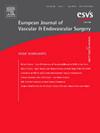Editor's Choice – Results of SurVeil Versus IN.PACT Admiral Paclitaxel Coated Balloons in Femoropopliteal Arteries: 24 Month Outcomes of the Randomised TRANSCEND Study
IF 5.7
1区 医学
Q1 PERIPHERAL VASCULAR DISEASE
European Journal of Vascular and Endovascular Surgery
Pub Date : 2025-03-01
DOI:10.1016/j.ejvs.2024.11.351
引用次数: 0
Abstract
Objective
The aim of the TRANSCEND study was to compare the safety and efficacy of the next generation SurVeil PCB with the IN.PACT Admiral PCB in patients with femoropopliteal arterial disease. SurVeil is a lower dose PCB (2.0 μg/mm2 vs. 3.5 μg/mm2 for IN.PACT Admiral) with a uniform microcrystalline coating intending to enhance durability and maximise drug delivery.
Methods
TRANSCEND is a prospective, single blind, randomised controlled, multicentre, non-inferiority clinical study. Patients with femoropopliteal artery disease in Rutherford stages 2 – 4 were randomised 1:1 to the SurVeil or the IN.PACT Admiral PCB. A sample size of 446 patients was calculated to prove non-inferiority of the SurVeil compared with the IN.PACT Admiral PCB for primary safety and efficacy endpoints at twelve months. Primary safety was defined as a composite of freedom from device and procedure related death through 30 days, and freedom from major target limb amputation and clinically driven (CD) target vessel revascularisation at twelve months. Primary efficacy was defined as primary patency at twelve months as a composite of freedom from binary re-stenosis and freedom from CD target lesion revascularisation. Secondary outcomes were reported up to twenty four months.
Results
A total of 446 subjects were randomised, 222 to the SurVeil and 224 to the IN.PACT Admiral PCB. Primary safety was 91.8% for the SurVeil vs. 89.8% for the IN.PACT Admiral PCB (pnon-inferiority < .001), and primary efficacy was 82.2% vs. 85.9% (pnon-inferiority = .003). Primary patency through twenty four months was 65.4% with the SurVeil and 66.9% with the IN.PACT Admiral PCB (pnon-inferiority = .005).
Conclusion
The next generation low dose SurVeil PCB demonstrated excellent safety and efficacy up to twenty four months and was non-inferior to the IN.PACT Admiral PCB. (ClinicalTrials registration ID: NCT03241459).
surveillance与IN的对比结果。股腘动脉PACT上将紫杉醇包覆球囊:24个月的TRANSCEND随机研究结果
目的:TRANSCEND研究的目的是比较下一代surveillance PCB与IN的安全性和有效性。股腘动脉疾病患者的pactip。监测是低剂量多氯联苯(2.0 μg/mm2vs)。IN为3.5 μg/mm2。PACT上将)具有均匀的微晶涂层,旨在提高耐久性和最大化药物输送。TRANSCEND是一项前瞻性、单盲、随机对照、多中心、非劣效性临床研究。卢瑟福2 - 4期股腘动脉疾病患者按1:1的比例随机分配到监测组或in组。海军上将。计算了446例患者的样本量,以证明与IN相比,该监测具有非劣效性。PACT Admiral PCB在12个月的主要安全性和有效性终点。主要安全性定义为30天内无器械和手术相关死亡,12个月时无主要靶肢截肢和临床驱动(CD)靶血管重建。主要疗效被定义为12个月时的主要通畅,即消除了二元再狭窄和消除了CD靶病变的血运重建。次要结果报告长达24个月。结果:共有446名受试者被随机分配,222名受试者接受监测治疗,224名受试者接受IN治疗。海军上将。surveillance的主要安全性为91.8%,而IN为89.8%。PACT Admiral组(p非劣效性< .001),主要疗效为82.2% vs. 85.9% (p非劣效性= .003)。24个月的一期通畅率,在SurVeil组为65.4%,在IN组为66.9%。PACT Admiral PCB(非劣效性= .005)。结论:新一代低剂量监测多氯联苯在24个月内具有良好的安全性和有效性,不逊于IN。海军上将。(ClinicalTrials注册ID: NCT03241459)。
本文章由计算机程序翻译,如有差异,请以英文原文为准。
求助全文
约1分钟内获得全文
求助全文
来源期刊
CiteScore
6.80
自引率
15.80%
发文量
471
审稿时长
66 days
期刊介绍:
The European Journal of Vascular and Endovascular Surgery is aimed primarily at vascular surgeons dealing with patients with arterial, venous and lymphatic diseases. Contributions are included on the diagnosis, investigation and management of these vascular disorders. Papers that consider the technical aspects of vascular surgery are encouraged, and the journal includes invited state-of-the-art articles.
Reflecting the increasing importance of endovascular techniques in the management of vascular diseases and the value of closer collaboration between the vascular surgeon and the vascular radiologist, the journal has now extended its scope to encompass the growing number of contributions from this exciting field. Articles describing endovascular method and their critical evaluation are included, as well as reports on the emerging technology associated with this field.

 求助内容:
求助内容: 应助结果提醒方式:
应助结果提醒方式:


